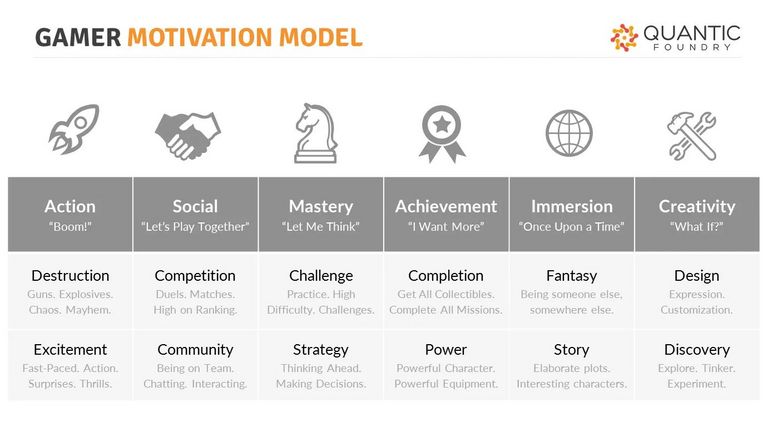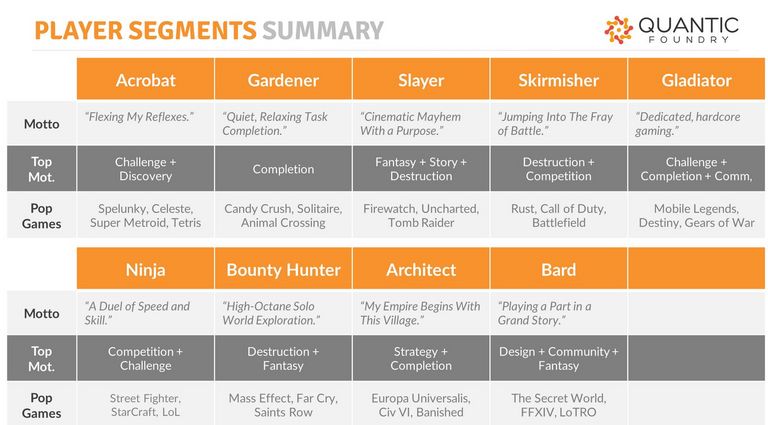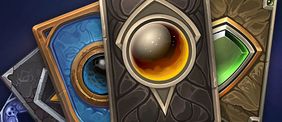Quantic Foundry´s nine gamer types and their association with narrative preferences
The current pandemic has caused the need for diverse games to rise – and while there are many research papers about which game genres, game features or game rules are preferred to help game companies shape the best content, there´s little to be found about game narrative preferences.
Thus, this explorative thesis focuses on identifying what kind of main characters, settings, villains, moods, story structures, perspectives and narrators are favoured by different kinds of gamers.
In order to categorize them, the Quantic Foundry gamer type quizzes are used, which reveal what drives users to play games and which Quantic Foundry gamer archetypes (Acrobat, Gardener, Slayer, Skirmisher, Gladiator, Bounty Hunter, Bard, Architect or Ninja) they align with.
After posting an online survey focusing on narrative preferences, 457 submissions were collected, and the narrative preferences of users with either of the nine primary Quantic Foundry gamer types identified – providing another perspective on player behaviour for the scientific field or a guideline for game developers.
However, it has been observed that within a group of users sharing the same primary Quantic Foundry gamer type (e.g., Acrobats), some questions weren´t answered unanimously – votes scattering across multiple choice options instead. The most likely reason for that is because some gamers can also have a secondary Quantic Foundry gamer type (e.g., Acrobats/Slayers), hinting towards narrative preferences differing within a group of gamers sharing a same primary type and that its presence has a heavier impact.
Due to the scope of the thesis, this assumption can´t be tested – giving opportunity for further research into the game narrative field, in relation to the Quantic Foundry gamer types instead.
The nine Quantic gamer types were identified via segment analysis of the 500,000+ gamers who have taken the Gamer Motivation Profile, based on their scores on the 12 motivations measured in the Quantic model:

The nine gamer types, player segments are: acrobats, gardener, slayer, skirmisher, gladiator, ninja, bounty hunter, architect, bard (s. details).

 |  |
Quantic Foundry´s nine gamer types and their association with narrative preferences:
TABLE OF CONTENT
1. INTRODUCTION
1.1. Subject relevance
1.2. Own interest/motivation
1.3. Research gap
1.4. Objectives and research questions
1.5. Limitations & scope
1.6. Impact on the industry
1.7. Significance for the scientific field
1.8. Structure/Overview
2.LITERATURE REVIEW & THEORETICAL FRAMEWORK
2.1. Literature review - “Games for Health”
2.2. Theoretical framework - Quantic Foundry
2.2.1. The motivation model and quiz
2.2.2. The 12 motivational drives
2.2.2.1. The destruction motivation
2.2.2.2. The excitement motivation
2.2.2.3. The competition motivation
2.2.2.4. The community motivation
2.2.2.5. The challenge motivation
2.2.2.6. The strategy motivation
2.2.2.7. The completion motivation
2.2.2.8. The power motivation
2.2.2.9. The fantasy motivation
2.2.10. The story motivation
2.2.2.11. The discovery motivation
2.2.2.12. The design motivation
2.2.3. Quantic Foundry’s nine gamer types
2.2.3.1. The Acrobat gamer type
2.2.3.2. The Gardener gamer type
2.2.3.3. The Slayer gamer type
2.2.3.4. The Skirmisher gamer type
2.2.3.5. The Gladiator gamer type
2.2.3.6. The Bounty Hunter gamer type
2.2.3.7. The Bard gamer type
2.2.3.8. The Architect gamer type
2.2.3.9. The Ninja gamer type
2.3. Theoretical framework - narrative preferences
2.3.1. Characters
2.3.1.1. Player-Character types
2.3.1.2. Differences between a protagonist and a viewpoint-character
2.3.1.3. Arc types
2.3.1.4. Villain motive types
2.3.1.5. Active or passive villain types
2.3.2. Story
2.3.2.1. Story focus types
2.3.2.2. Narrative branching types
2.3.2.3. Performance types
2.3.2.4. Conflict types
2.3.2.5. Ending types
2.3.3. Perspectives and narrators
2.3.3.1. Perspective types
2.3.3.2. Narrator types
2.3.4. Settings
2.3.5. Game genres
3. METHODOLOGY
3.1. The selected methods
3.1.1. Expert interviews
3.1.2. Surveys
3.2. Application of methods in previous studies
3.3. What do they explore/how is it useful for the research gap?
3.4. Application of methods and their limitations
3.4.1. Application of expert interviews
3.4.2. Application of survey
4. FINDINGS
4.1. Expert Interviews
4.1.1. Participant A´s perspective
4.1.2. Participant B´s perspective
4.2. Online survey
4.2.1. Overview of gamer types
4.2.2. Character preferences
4.2.2.1. Main character preferences
4.2.2.2. Villain preferences
4.2.3. Setting and mood preferences
4.2.3.1. Setting preferences
4.2.3.2. Mood preferences
4.2.4. Story structure preferences
4.2.5. Perspective and narrator preferences
4.2.5.1. Perspective preferences
4.2.5.2. Narrator preferences
4.2.6. Genre preferences
5. DISCUSSION OF FINDINGS & CONCLUSION
5.1. Discussion of expert interviews findings
5.2. Discussion of survey findings
5.2.1. Acrobat gamer types
5.2.2. Gardener gamer types
5.2.3. Slayer gamer types
5.2.4. Skirmisher gamer types
5.2.5. Gladiator gamer types
5.2.6. Bounty Hunter gamer types
5.2.7. Bard gamer types
5.2.8. Architect gamer types
5.2.9. Ninja gamer types
5.3. Conclusion and potential for further research
5.4. Impact on industry/society
5.5. Lessons learned and limitations
Free download master thesis by Sofia Sabarini : HERE.

Sofia Sabarini
Contact: LinkedIn


